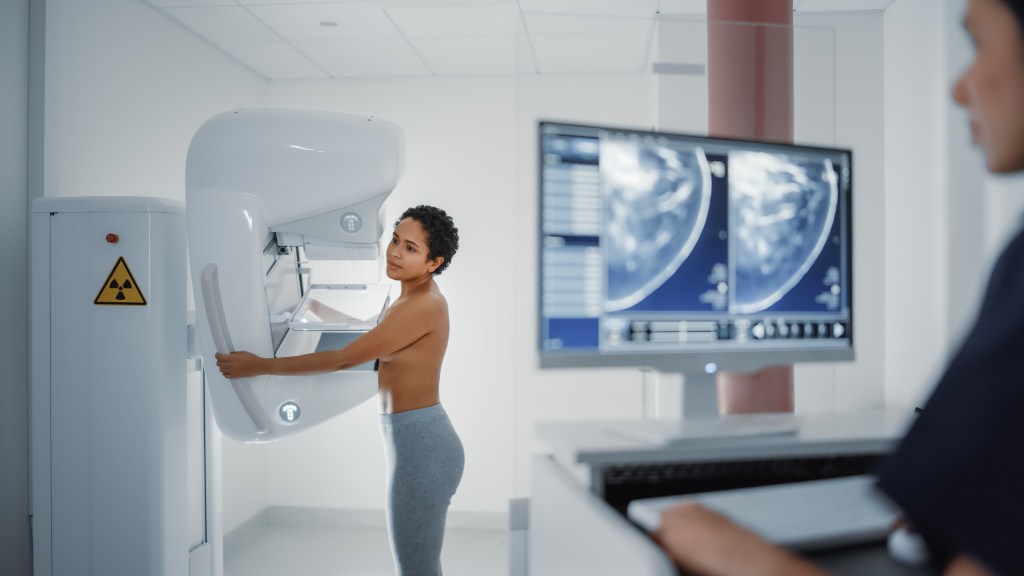Why AI Breast Cancer Screenings Aren’t Accurate for Black Women

[ad_1]
Artificial intelligence, better known as AI, entered the breast mammography space to enhance interpretation of malignancy in breast tissue, detect breast cancer before it reaches advanced stages, and reduce rates of false positives or false negatives for the presence of cancer. There are a number of benefits, including lowering stress levels, unnecessary biopsies, and financial burdens that cancer patients and survivors experience when traditional mammograms are irregular.
So how does it work? Based on data programmed into a computer, an AI algorithm creates a standard to determine malignancy and risk scores that will directly impact the level of care a patient receives. The Food and Drug Administration believes this information will help researchers understand the relationship between patient characteristics: age, ethnicity, breast density, malignancy, and risk, with the ultimate goal of reducing rates of breast cancer. It’s a worthy goal, but experts have found one major issue: the success of AI screenings for white and Asian women compared to disappointing outcomes for Black women.
Dr. Regina Barzilay is a professor of electrical engineering and computer science at MIT who specializes in the intersection of AI and health. While not involved in the Duke study, Dr. Barzilay told SheKnows that AI tools may sometimes “underperform on certain racial or demographic groups if they are underrepresented in the training data on which the algorithm is developed.”
The Duke Medical team wasn’t the only group to show this type of bias in the research. Other studies focused their efforts on European women and most clinical trials were outside of the United States, further erasing unique markers of Black women in their reports. “One big fix that needs to happen is to have large datasets of mammograms that represent a diverse patient population,” Dr. Barzilay noted. “Another important aspect is testing these models in different demographic groups to ensure that they are unbiased.”
The problem is, the FDA does not require diversity of data, continuing to rely on racially biased risk assessment tools like Tyrer-Cuzick or the Gail Model that do not factor in family history of cancer or racial or ethnic differences when creating guidelines — and that affects these AI screenings. According to Breastcancer.org, technicians train the AI by entering millions of images into computers so AI software can convert the information into a mathematical representation of what a normal mammogram looks like and what a mammogram with cancer looks like. From that information, the AI creates a baseline that becomes the standard of what normal breast tissue looks like. But if that baseline is based on a dataset that’s skewed towards a certain demographic, that means the current AI screening practices may not be the best option for those outside the demographic; in this case, non-white and older women.
The Duke study reveals the limitations of AI breast cancer screenings that we still need to overcome. For Black women who are genetically predisposed to breast cancer due to first degree (parent, child, or cousin) family history or presence of the BRCA gene, or even low risk candidates hoping to stave off the disease, the news is discouraging. As long as the standard for normal breast tissue excludes patient characteristics along race, health, and life span, outlooks for Black women remain poor.
Inequities in health care for Black women are not new, and medical professionals are dedicating their careers to understanding why this demographic is prone to more advanced stages of breast cancer and cancers in general. Dr. Melissa Davis of Morehouse Medical College is one who has answered the call with SAMBAI, which stands for Social, Ancestry, Molecular and Biological Analysis of Inequalities. With a $25 million dollar grant from the Cancer Grand Challenges, Dr. Davis’ team is committed to creating a database of 40,000 people from multiple African countries, as well as people of recent African heritage in the UK and US, to ensure representation for more accurate data collection. After all, AI algorithms are only as good as the information they’re given.
Another option to improve AI screenings of Black women is MIRAI, an AI screening tool developed by Dr. Barzilay and Dr. Adam Yala, an assistant professor in computational precision health, statistics, and computer science at UCSF and UC Berkeley. According to Dr. Barzilay, “MIRAI addresses a different task: we aim to predict future risk of the disease. It is important because it enables extra screening and preventative resources for women who are at high risk.” And it’s especially relevant for Black women, who are diagnosed with breast cancer at a younger age, on average, than white women, according to research. “At the same time, we don’t want to over screen them,” Dr. Barzilay added. “One possible scenario is to screen them first at a younger age in order to identify a small cohort of women who are truly high risk and who need to be screened differently.”
So far, only 9% of radiologists in the United States are regularly using AI for breast imaging, according to Breastcancer.org. It’s also important to note that the technology will not replace human clinicians. Rather, it will help reduce and manage the workload of radiologists to improve outcomes for breast cancer patients with more accurate screenings. Undoubtedly, AI breast imaging could be a life-saving screening tool — but that will not happen until all women are represented in its algorithms.
Before you go, shop these gifts for breast cancer patients and survivors:
[ad_2]






